
Izatha rigescens is a species of moth in the family Oecophoridae. It is endemic to New Zealand. This species is classified as having the conservation status of "Data Deficient" by the Department of Conservation. It is only known from the Wellington coast. This species has not been seen since 1929.
Heterocrossa contactella is a species of moth in the family Carposinidae. It is endemic to New Zealand.
Heterocrossa gonosemana is a species of moth in the family Carposinidae. It is endemic to New Zealand.
Petasactis is a genus of moths belonging to the family Tineidae. It contains only one species, Petasactis technica, which is endemic to New Zealand. This species has not been collected since prior to 1888. It is classified as "Data Deficient" by the Department of Conservation.
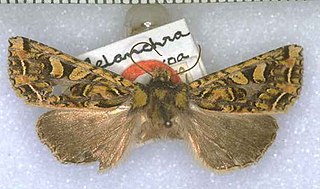
Meterana tetrachroa is a species of moth of the family Noctuidae. This species is endemic to New Zealand. It is classified as "Data Deficient" by the Department of Conservation.

Pyrausta comastis is a moth in the family Crambidae. This species is endemic to New Zealand. It has been classified as "nationally vulnerable" by the Department of Conservation.
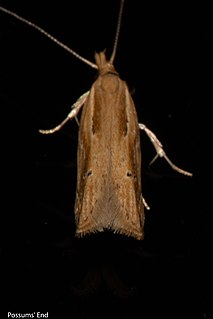
Eutorna symmorpha is a moth in the family Depressariidae. It was described by Edward Meyrick in 1889. It is endemic to New Zealand.

Crypsitricha agriopa is a species of moth in the family Tineidae. It was described by Edward Meyrick in 1888. This species is endemic to New Zealand.
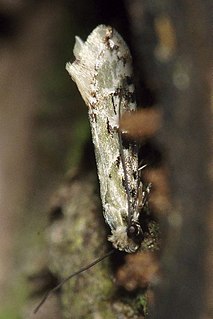
Crypsitricha mesotypa is a species of moth in the family Tineidae. It was described by Edward Meyrick in 1888. This species is endemic to New Zealand.

Crypsitricha pharotoma is a species of moth in the family Tineidae. It was described by Edward Meyrick in 1888. This species is endemic to New Zealand.

Crypsitricha roseata is a species of moth in the family Tineidae. It was described by Edward Meyrick in 1913. This species is endemic to New Zealand. The type locality of this species is the suburb of Wadestown, in Wellington.

Asaphodes cosmodora is a species of moth in the family Geometridae. This species is endemic to New Zealand and has been observed in the South Island. The adults of this species are on the wing in January and February.

Tingena ancogramma is a species of moth in the family Oecophoridae. It is endemic to New Zealand and has been found in the Hen and Chicken Islands, the North Island and the South Island. Adults are on the wing in summer and autumn and inhabit open areas of forest scrubland.
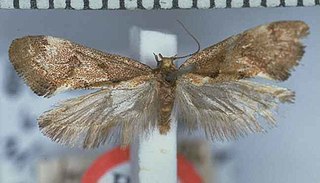
Tingena brachyacma is a species of moth in the family Oecophoridae. It is endemic to New Zealand and has been found in the south of the South Island. This species inhabits open swamps, native forest and scrubland and has been collected amongst Leptospermum. The adults of the species are on the wing in November and December.
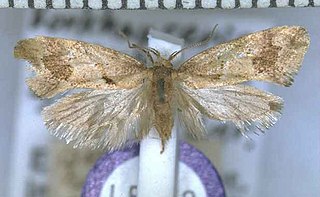
Tingena penthalea is a species of moth in the family Oecophoridae. It is endemic to New Zealand and has been observed in Wellington and the Tararua Range. The adults of this species are on the wing from December until February.
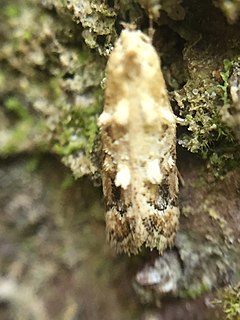
Trachypepla aspidephora is a species of moth in the family Oecophoridae. It is endemic to New Zealand and has been observed in the North and South Islands. Adults are on the wing from November to March and are attracted to light. The moths can be found resting on tree trunks where their colouration imitates lichens.

Trachypepla importuna is a moth of the family Oecophoridae first described by Edward Meyrick in 1914. It is endemic to New Zealand. Adults have been collected in the North Island in January but the species is regarded as being poorly known.

Trachypepla protochlora is a moth of the family Oecophoridae first described by Edward Meyrick in 1883. It is endemic to New Zealand and is found in both the North and South Islands. The preferred habitat of this species is native forest and adults are on the wing from October until February. Adults can be variable in their green shaded colour as well as in the intensity of markings on their forewings. The greenish ground colouration of this moth ensures they are well camouflaged when at rest on green mosses and lichens.

Trachypepla spartodeta is a moth of the family Oecophoridae first described by Edward Meyrick in 1883. It is endemic to New Zealand and has been collected in both the North and South Islands. This species inhabits native forest and adults are on the wing from November to January.

Orthenches chlorocoma is a moth of the family Plutellidae first described by Edward Meyrick in 1885. It is endemic to New Zealand and has been observed in the North and South Islands.


















